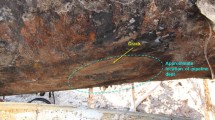Abstract
There are more than 2.5 million miles of oil and gas pipelines in the USA. Government regulations require that buried or submerged petroleum pipelines be externally coated and cathodically protected if installed after July 31, 1971. As demands shift, or oil and gas fields are depleted, pipelines can be mothballed, to maintain integrity in the interim, or permanently abandoned. When pipelines are removed from service, the environment must be safeguarded from residual product and potentially hazardous contaminants that may remain in the pipeline. Recently, procedures have been developed in order to safeguard the environment from the hazards associated with abandoned pipeline structures. Natural force damage (which includes weather, among other naturally occurring events) was attributed to 9% of incidents involving hazardous liquid pipelines from 2002 to 2003. On-shore pipelines are typically buried at depths where ambient soil temperature is relatively constant, and above freezing. However, it is common for portions of pipelines to be aboveground, for example at meter stations, or at crossings. Consequently, aboveground pipelines are subject to ambient air temperatures. This paper provides a case history in which a failure analysis was used to determine the metallurgical cause of a failure involving a mothballed hydrocarbon pipeline that was exposed to freezing temperatures.











Similar content being viewed by others
References
W.T. Becker, R.J. Shipley, Glossary, ASM Handbook, Volume 11: Failure Analysis and Preventioned (ASM International, Materials Park, 2002)
ASTM, A370 Standard test methods and definitions for mechanical testing of steel products (2012)
M.J. Rosenfeld, A simple procedure for synthesizing Charpy impact energy transition curves from limited test data, in 1996 1st International Pipeline Conference (American Society of Mechanical Engineers, 1996), pp. 215–221
W. Maxey, J. Kiefner, R.J. Eiber, NG-18 Report, Brittle Fracture Arrest in Gas Pipelines No. (135) (1983)
Author information
Authors and Affiliations
Corresponding author
Additional information
Publisher's Note
Springer Nature remains neutral with regard to jurisdictional claims in published maps and institutional affiliations.
Rights and permissions
About this article
Cite this article
Ritchie, P., Quickel, G. Ice Ice or Under Pressure? Mothballed Pipeline Failure. J Fail. Anal. and Preven. 19, 1188–1194 (2019). https://doi.org/10.1007/s11668-019-00697-9
Received:
Published:
Issue Date:
DOI: https://doi.org/10.1007/s11668-019-00697-9




